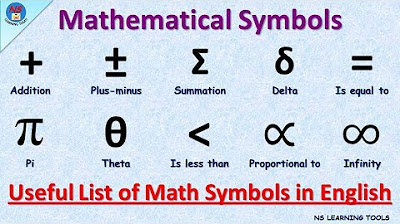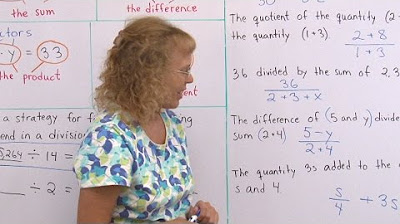Addition and Subtraction of Small Numbers
TLDRThe script provides a historical perspective on mathematics, explaining how addition and subtraction operations arose from simple human needs like counting tribe members and trading goods. It breaks down the conceptual meaning behind the math symbols, walking through basic examples of addition and subtraction equations. The properties of numbers are also discussed in relation to the operations, such as commutativity and associativity. The goal is to make math less confusing and arbitrary by deeply understanding what the constructs represent in concrete terms.
Takeaways
- 😀 Math originated from the basic human need to count, track inventory, trade goods etc.
- 😊 The decimal number system we use today is based on 10 fingers humans have.
- 🤓 Addition represents combining numbers to get a sum; subtraction finds the difference between numbers.
- 😎 Addition is commutative (order doesn't matter) but subtraction is not.
- 🧐 Addition is associative but subtraction is not.
- 🤔 All math operations and symbols, no matter how complex, are grounded in concrete physical concepts.
- 👍 Making math concepts intelligible and relatable is key to overcoming frustration with the subject.
- 😀 Arithmetic began with addition and subtraction as the first operations developed.
- 😌 The goal is to make all math operations as easy to understand as addition and subtraction.
- 🤓 Properties like commutativity and associativity are key to arithmetic and more advanced math.
Q & A
What was the first kind of math developed by humans?
-The first kind of math developed was arithmetic, which was needed shortly after humans learned to count in order to represent numbers and manipulate them in ways that model real-world concepts like tracking tribe populations and trading goods.
Why did early civilizations need to develop math concepts like addition and subtraction?
-Early civilizations needed math operations like addition and subtraction to keep track of inventory, appropriately price goods, and perform other practical tasks related to trade and commerce.
Why is our number system based on the number 10?
-Our number system is based on 10 because humans have 10 fingers and many early counting systems were based on counting with our fingers. The base-10 system stuck over other options like base-20 or base-60.
What does the equals sign mean in a mathematical equation?
-The equals sign means that the expressions on the left and right sides of the sign are numerically equivalent or have the same value.
What is the difference between addition and subtraction?
-Addition combines two numbers into a sum. Subtraction finds the difference between two numbers by taking one number away from the other.
Why is addition commutative but subtraction is not?
-Addition is commutative because changing the order of the addends does not change the sum. But for subtraction, which number is being subtracted from the other matters for the difference.
Why is addition associative but subtraction is not?
-Addition is associative because changing the grouping of addends does not affect the sum. But regrouping subtractions can give different results, so it is not associative.
How can a number line help visualize subtraction?
-A number line shows the distance between two numbers that are being subtracted. This distance represents their difference.
How can complicated math still connect back to basic concepts?
-Even very advanced math using complex symbols and equations originates from basic real-world concepts and actions like combining, separating, and comparing amounts and values.
What is one main goal mentioned for this math series?
-One main goal is to make all mathematical operations understandable by deeply explaining what the symbols and constructs actually represent so the utility and meaning becomes clear.
Outlines
😊 Understanding the Origins and Basics of Arithmetic
The first paragraph provides background on how arithmetic emerged from the basic human need to count and track items. It explains how numeric systems and early addition and subtraction operations arose as civilizations developed trading and agriculture. The key focus is on how arithmetic has very simple roots based on real-world necessities.
📏 Exploring Key Properties of Addition and Subtraction
The second paragraph delves deeper into addition and subtraction, covering commutative, associative, and other properties. It stresses the concrete meaning behind all mathematical symbols and operations, aiming to make even advanced constructs relatable.
Mindmap
Keywords
💡arithmetic
💡addition
💡subtraction
💡number line
💡equation
💡sum
💡difference
💡associative
💡commutative
💡order of operations
Highlights
Math began simply as part of language, to communicate ideas and describe surroundings.
Mathematical innovations arose by necessity, and still do today.
Addition represents combining numbers into a sum.
Subtraction finds the difference between two numbers.
Subtraction is the inverse of addition.
Equations state equality between two expressions.
Addition is commutative - order does not matter.
Subtraction is not commutative - order matters.
Addition is associative - grouping does not affect the result.
Subtraction is not associative - grouping affects the result.
Properties like commutativity become important but less obvious later on.
All mathematical symbols represent something concrete.
Mathematical constructs seem less arbitrary when their utility is apparent.
Arithmetic is the foundation for more advanced math.
Understanding what math represents makes it more comprehensible.
Transcripts
Browse More Related Video

List of Mathematical Symbols in English | Math Symbols Vocabulary | 65 Mathematics Symbols

Intro to Matrices

Terminology for the basic operations and writing algebraic expressions from words

Multiplication and Division of Small Numbers

GED MATH 2024 Preparation Course - from the Absolute Beginning to Advanced Level

Maths Symbols & Equations - English Vocabulary | Maths Vocabulary | Math or Maths | Basic Math
5.0 / 5 (0 votes)
Thanks for rating: